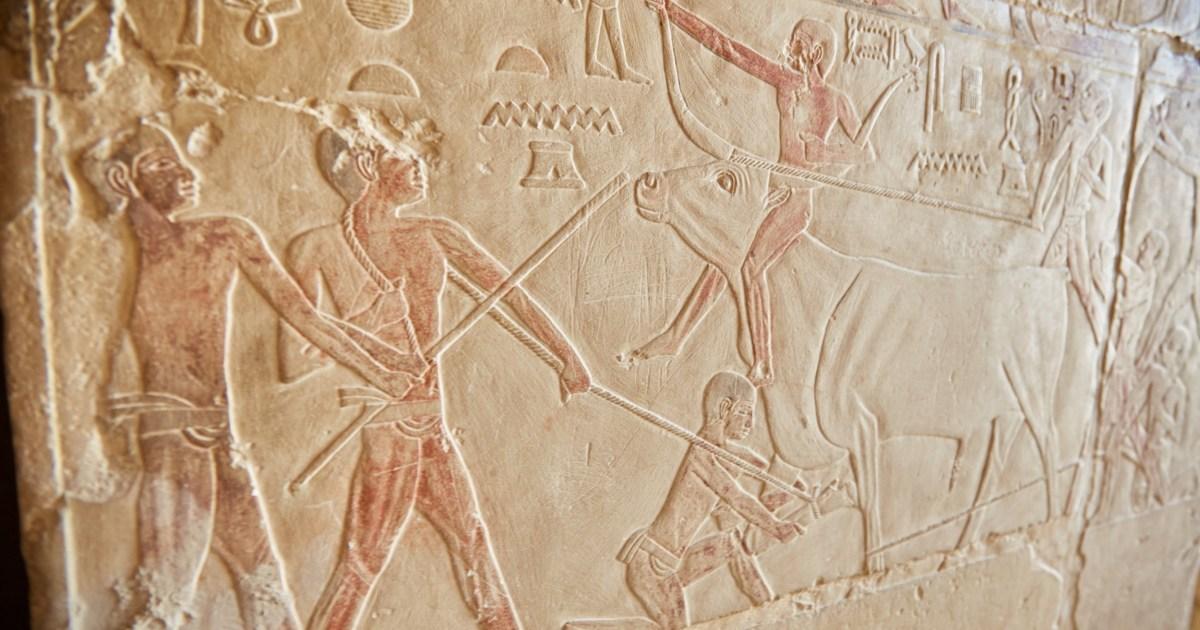World
Rare 4,000-Year-Old Limestone Carving Stolen from Egyptian Tomb

A valuable limestone carving, estimated to be around 4,000 years old, has gone missing from the Saqqara necropolis in Egypt, according to officials from the Egyptian Ministry of Antiquities. The theft occurred shortly after a separate incident involving a stolen golden bracelet from the Egyptian Museum, which was reportedly melted down and sold.
The limestone piece belonged to the tomb of Khentika, dating back to the sixth dynasty of the Old Kingdom, approximately between 2700 BC and 2200 BC. This tomb was first discovered in the 1950s and had remained unopened since 2019. In May, a British archaeological team working in the area found that the relief, which depicts scenes of daily life in ancient Egypt, was missing.
The theft has been described as a “catastrophe,” as the limestone art was cut out of the wall of the tomb. In response, security measures surrounding Egyptian antiquities have been intensified following the recent incidents.
On September 9, 2023, a set of lapis lazuli bead jewellery, linked to Pharaoh Amenemope, was stolen from the Egyptian Museum in Cairo. The artefact was sold for approximately £2,819, and reports indicate that a restoration specialist from the museum was involved in the theft before it passed through a series of dealers and was ultimately melted down.
Four suspects have been arrested in the case, including the museum restoration specialist, as prosecutors continue their investigation. Prominent Egyptian archaeologist Monica Hanna has called for improved security protocols for artefacts, particularly after it was revealed that the museum lab where the jewellery was stolen lacked security cameras.
The recent thefts come on the heels of an incident involving the British Museum, where an employee was dismissed following the discovery of stolen items, including gold, jewellery, and semi-precious stones dating from the 15th century BC to the 19th century AD. The museum has stated that the majority of these items were small pieces kept in a storeroom.
In light of these events, Hartwig Fischer, director of the British Museum, expressed regret over the situation, stating, “The museum apologises for what has happened, but we have now brought an end to this—and we are determined to put things right.” He assured the public that efforts to recover missing objects would be undertaken, alongside enhanced security measures.
As the investigation into the theft of the limestone carving continues, the cultural heritage of Egypt remains at risk, prompting ongoing discussions about the need for better protection of its antiquities.
-

 World2 days ago
World2 days agoCoronation Street’s Shocking Murder Twist Reveals Family Secrets
-

 Entertainment4 months ago
Entertainment4 months agoKate Garraway Sells £2 Million Home Amid Financial Struggles
-

 Entertainment3 months ago
Entertainment3 months agoAnn Ming Reflects on ITV’s ‘I Fought the Law’ Drama
-

 Health3 months ago
Health3 months agoKatie Price Faces New Health Concerns After Cancer Symptoms Resurface
-

 Entertainment3 weeks ago
Entertainment3 weeks agoCoronation Street Fans React as Todd Faces Heartbreaking Choice
-

 World3 weeks ago
World3 weeks agoBailey Announces Heartbreaking Split from Rebecca After Reunion
-

 Entertainment5 days ago
Entertainment5 days agoTwo Stars Evicted from I’m A Celebrity Just Days Before Finale
-

 World5 days ago
World5 days agoKevin Sinfield Exceeds Fundraising Goal Ahead of Final Marathons
-

 Entertainment3 months ago
Entertainment3 months agoCoronation Street’s Carl Webster Faces Trouble with New Affairs
-

 Entertainment3 months ago
Entertainment3 months agoWhere is Tinder Swindler Simon Leviev? Latest Updates Revealed
-

 Entertainment4 months ago
Entertainment4 months agoMarkiplier Addresses AI Controversy During Livestream Response
-

 Science2 months ago
Science2 months agoBrian Cox Addresses Claims of Alien Probe in 3I/ATLAS Discovery









